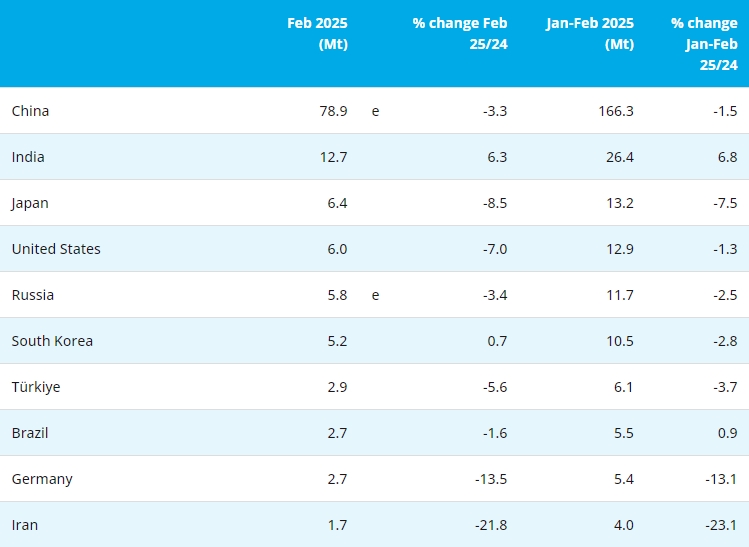Russell@ (Repeats with no changes to text. The opinions expressed here are those of the author, a columnist for Reuters.)
LAUNCESTON, Australia, Sept 11 (Reuters) - China's imports of major commodities in August illustrate both why prices have gained in recent months and why this rally may be running out of steam.
Imports of crude oil, copper, coal and iron ore remained relatively robust in August, but the customs data released on Sept. 8 also showed a certain loss of momentum.
Crude oil imports were 33.98 million tonnes, equivalent to about 8 million barrels per day (bpd), which was the lowest in about eight months and down from 8.18 million bpd in July.
While an explanation can be found in maintenance closures by refineries and ramped up environmental inspections by the authorities, it does appear that China's crude oil imports have been losing some momentum.
The year-on-year increase for the first eight months of 2017 was 12.2 percent, which is still robust.
But it is also down from 13.6 percent in July and 13.8 percent in June, showing that while overall growth in imports is still well up in year-on-year terms, it is starting to slow somewhat.
It's a similar story for coal, which has been an area of standout strength for imports this year.
China brought in 25.27 million tonnes of coal in August, which was almost 30 percent higher than July's 19.46 million, but down 5 percent from August last year.
In year-to-date terms, coal imports were 14.2 percent higher for the first eight months of 2017, but this was down from 18.2 percent in July and 23.5 percent in June.
For iron ore, August also looked quite strong, with imports of 88.66 million tonnes, up from July's 86.25 million.
But for the first eight months of the year, iron ore imports were 6.7 percent higher than for the same period in 2016, down from July's 7.5 percent and June's 9.3 percent.
Overall, the picture that emerges from China's imports of crude, coal and iron ore is that while the growth rates still look strong, they have been tapering off in recent months.
That helps justify why commodity prices rallied hard in recent months, and why they are starting to look a little stretched.
COAL, IRON ORE RALLIES STALL
This is especially the case for coal and iron ore, where China's import demand is a major driver of price, given that the country is the top importer of both, and utterly dominates iron ore, taking about two-thirds of seaborne cargoes.
Newcastle thermal coal futures, a regional benchmark, rallied from a close of $71.30 a tonne on May 16 to $102.50 on Aug. 8, a gain of almost 44 percent.
Since then, the contract has traded sideways and was at $102.45 at the close of Sept. 8.
Singapore-traded iron ore futures, which are based on the spot price for cargoes to China, went from $53.66 a tonne on June 13 to $75.63 on Aug. 7, a jump of 41 percent.
Since then, they have moved in a relatively narrow band, ending on Sept. 8 at $74.21 a tonne.
Among major Chinese commodity imports, the outlier appears to be copper.
Imports of unwrought copper were 390,000 tonnes in August, the exact same number as for July and June, according to customs data.
In year-to-date terms, unwrought copper imports were down 12.7 percent in August, which was actually better than July's decline of 15.2 percent, but both were below the gain of 3.6 percent in June.
Overall, this isn't a picture of robust copper imports, at best it's a steady-as-she-goes scenario, which stands in contrast to the recent strong rally in copper prices.
London-traded copper futures gained 26 percent from the low so far this year in early April to a recent closing peak of $6,917 a tonne on Sept. 4.
A 3 percent drop on Sept. 8 knocked the price back to a close of $6,693 a tonne, with some of the decline blamed on market disappointment with the Chinese trade figures.
While China does exert influence on copper prices, it doesn't have quite the same dominance as it does for coal and iron ore.
This means copper's recent rally has been achieved despite the mixed Chinese import data, with concerns about supply helping boost prices.
But it's difficult to see copper prices sustaining their recent rally without increasing demand from China, the top importer of the industrial metal.
Overall, it's hard to argue that China's demand for imported commodities is weak, with most showing strong year-to-date gains.
However, it is possible to argue that some of momentum appears to have been lost in recent months, and while this doesn't mean prices are on the verge of a retreat, it does make it harder for them to sustain rallies.
(Editing by Joseph Radford)
- [Editor:Wang Linyan]

庫4.jpg)

 Save
Save Print
Print Daily News
Daily News Research
Research Magazine
Magazine Company Database
Company Database Customized Database
Customized Database Conferences
Conferences Advertisement
Advertisement Trade
Trade








?bào)/2024/QQ截圖20250402170922.png)
?bào)/2024/微信圖片_20250328161757.jpg)


 Online inquiry
Online inquiry Contact
Contact

Tell Us What You Think